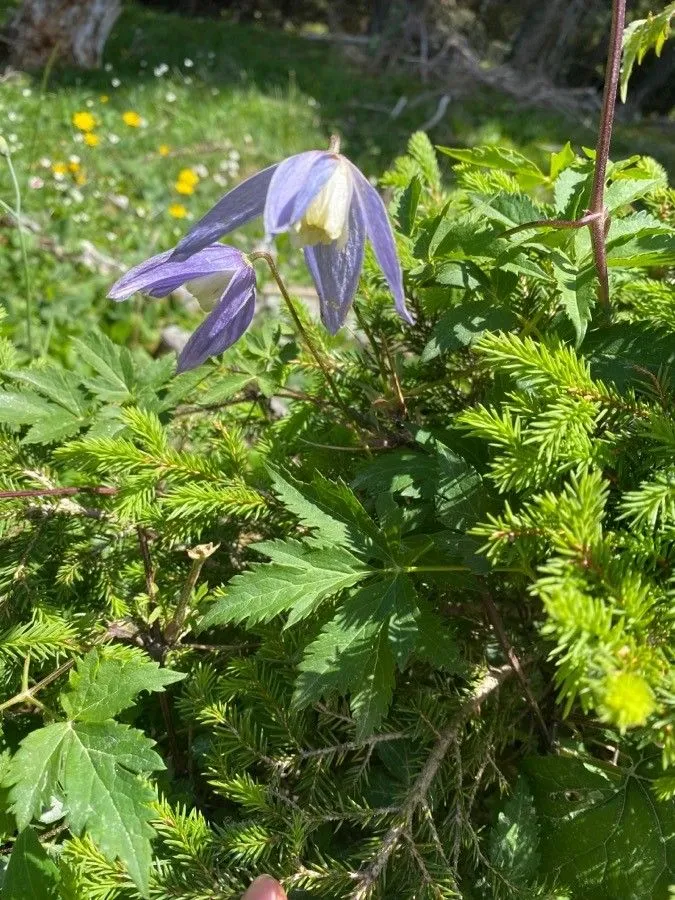
Author: (L.) Mill.
Bibliography: Gard. Dict. ed. 8: n.º 9 (1768)
Year: 1768
Status: accepted
Rank: species
Genus: Clematis
Vegetable: False
Observations: European Mts.
The Alpine clematis, scientifically known as Clematis alpina, is a captivating species that belongs to the Ranunculaceae family. First detailed in the 8th edition of “Gardener’s Dictionary” in 1768 by the botanist (L.) Mill., this delightful plant has a rich history of being admired for its exquisite beauty and resilience.
The Alpine clematis is indigenous to the mountainous regions of Europe, where it thrives in the cool, temperate climates. It is a hardy climber, often found adorning rocky outcrops and wooded slopes, making the most of its rugged surroundings.
This deciduous perennial is celebrated for its charming, nodding flowers, which typically bloom in spring. The blossoms are usually a stunning shade of blue to purple, adding a splash of color to the alpine landscape. The flower structure consists of four petal-like sepals surrounding a cluster of delicate stamens, giving it a delicate yet striking appearance.
In addition to its visual appeal, Clematis alpina is also valued for its ecological role. It provides habitat and food for various pollinators, including bees and butterflies, which contribute to the biodiversity of its native regions.
Gardeners appreciate the Alpine clematis for its low-maintenance nature and versatility. It can be grown on trellises, fences, and even allowed to sprawl over rock gardens, where it can create a natural, untamed beauty. With its ability to withstand cold temperatures and its modest demands, it makes an excellent choice for gardens in cooler climates.
Overall, Clematis alpina represents a perfect blend of aesthetic charm and robustness, embodying the serene yet powerful essence of the European mountains from which it hails. Its presence in both the wild and cultivated gardens continues to inspire plant enthusiasts and nature lovers alike.
Deu: alpen-waldrebe
Swe: alpklematis, alppikärhö
Fin: alppikärhö
Nob: alpeklematis
Nno: alperanke
En: Alpine Clematis, Alpine Virgin’s-bower, Siberian clematis
Hy: Աթրագեն ալպիական
Bg: Алпийски повет
Zh: 半钟铁线莲
Cs: Plamének alpský
Nl: Alpenbosrank, Alpenrank
Et: Siberi elulõng
Fi: Alppikärhö
Fr: Atragène des Alpes, Clematite des Alpes, Clématite des Alpes
De: Alpen-Waldrebe, Alpenwaldrebe, Alpen Waldrebe, Alpenrebe, Berg Rebe
Hu: Havasi iszalag
It: Clematide alpina, Atragene alpina, Vitalbino dei sassi
Ko: 자주종덩굴
Nb: Alpeklematis
Nn: Alperanke
Pl: Powojnik alpejski
Ro: Curpen de munte
Ru: Клематис альпийский, Ломонос альпийский
Sk: Plamienok alpínsky
Sv: Alpklematis, Alppikärhö
: Alpine clematis
© copyright of the Board of Trustees of the Royal Botanic Gardens, Kew.
© copyright of the Board of Trustees of the Royal Botanic Gardens, Kew.
© copyright of the Board of Trustees of the Royal Botanic Gardens, Kew.
Taken Apr 30, 2020 by Olivier Le Gall (cc-by-sa)
Taken Sep 26, 2021 by Laura Bonet (cc-by-sa)
Taken May 24, 2018 by orsatus (cc-by-sa)
Taken May 2, 2019 by S. S. (cc-by-sa)
Taken Mar 23, 2019 by kaatje (cc-by-sa)
Taken Jun 10, 2021 by Lennaert Steen (cc-by-sa)
Taken Jul 1, 2021 by jean-jacques kelner (cc-by-sa)
Taken Jun 25, 2020 by Alberto (cc-by-sa)
Taken Aug 12, 2019 by Pedrocchi César (cc-by-sa)
Taken Sep 26, 2021 by Laura Bonet (cc-by-sa)
Taken Jul 11, 2014 by Tela Botanica − Liliane Roubaudi (cc-by-sa)
Taken Aug 4, 2009 by Tela Botanica − Yoan MARTIN (cc-by-sa)
Taken Apr 30, 2020 by Olivier Le Gall (cc-by-sa)
Taken Aug 12, 2019 by Pedrocchi César (cc-by-sa)
Taken Sep 26, 2021 by Laura Bonet (cc-by-sa)
Taken Aug 15, 2013 by Photoflora – Benoit BOCK (©)
Taken Apr 15, 2022 by manuseitz (cc-by-sa)
Taken Apr 19, 2022 by Jim Knopf (cc-by-sa)
Taken Apr 19, 2022 by Jim Knopf (cc-by-sa)
Taken Apr 19, 2022 by Jim Knopf (cc-by-sa)
Taken May 25, 2017 by Yoan MARTIN (cc-by-sa)
Taken Aug 9, 2020 by Emanuele Santarelli (cc-by-sa)
Taken Feb 2, 2022 by Marc Horisberger (cc-by-sa)
Taken Jul 8, 2015 by Tela Botanica − Yoan MARTIN (cc-by-sa)
Taken Aug 12, 2019 by Pedrocchi César (cc-by-sa)
Taken Aug 22, 2021 by pasforchange (cc-by-sa)
Taken Jul 29, 2022 by Annemarie Dunant (cc-by-sa)
Taken Feb 19, 2022 by Beate Liebold (cc-by-sa)
Taken Jul 8, 2015 by Tela Botanica − Yoan MARTIN (cc-by-sa)
Growth habit: Vine
Ph maximum: 6.5
Ph minimum: 5.5
Light: 5
Atmospheric humidity: 5
Bloom months: [‘jun’, ‘jul’]
Soil nutriments: 4
Family: Myrtaceae Author: (F.Muell.) K.D.Hill & L.A.S.Johnson Bibliography: Telopea 6: 402 (1995) Year: 1995 Status:…
Family: Rubiaceae Author: Pierre ex A.Froehner Bibliography: Notizbl. Bot. Gart. Berlin-Dahlem 1: 237 (1897) Year:…
Family: Sapindaceae Author: Koidz. Bibliography: J. Coll. Sci. Imp. Univ. Tokyo 32(1): 38 (1911) Year:…
Family: Asteraceae Author: A.Gray Bibliography: Pacif. Railr. Rep.: 107 (1857) Year: 1857 Status: accepted Rank:…
Family: Fabaceae Author: Medik. Bibliography: Vorles. Churpfälz. Phys.-Ökon. Ges. 2: 398 (1787) Year: 1787 Status:…
Family: Aspleniaceae Author: (Cav.) Alston Bibliography: Bull. Misc. Inform. Kew 1932: 309 (1932) Year: 1932…